
St. Joseph is a city in and the county seat of Buchanan County, Missouri. Small parts of St. Joseph extend into Andrew County. Located on the Missouri River, it is the principal city of the St. Joseph Metropolitan Statistical Area, which includes Buchanan, Andrew, and DeKalb counties in Missouri and Doniphan County, Kansas. As of the 2010 census, St. Joseph had a total population of 76,780, making it the eighth largest city in the state, and the third largest in Northwest Missouri. St. Joseph is located roughly thirty miles north of the Kansas City, Missouri city limits and approximately 125 miles south of Omaha, Nebraska.
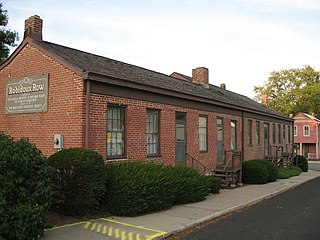
Joseph Robidoux IV (1783–1868), was a French-American fur trader credited as the founder of St. Joseph, Missouri, which developed around his Blacksnake Hills Trading Post. His buildings in St. Joseph, known as Robidoux Row, are listed on the National Register of Historic Places. Of French Canadian descent, he was born in Saint Louis, as were his mother and most of his brothers, when it was a predominately French colonial town.

Will Mayfield College was a Baptist school located in Marble Hill, Missouri. From 1878 to 1934, the college offered four years of preparatory school and two years of junior college work.

The Pony Express Museum is a transport museum in Saint Joseph, Missouri, documenting the history of the Pony Express, the first fast mail line across the North American continent from the Missouri River to the Pacific coast. The museum is housed in a surviving portion of the Pike's Peak Stables, from which westward-bound Pony Express riders set out on their journey.

Cabanne's Trading Post was established in 1822 by the American Fur Company as Fort Robidoux near present-day Dodge Park in North Omaha, Nebraska, United States. It was named for the influential fur trapper Joseph Robidoux. Soon after it was opened, the post was called the French Company or Cabanné's Post, for the ancestry and name of its operator, Jean Pierre Cabanné, who was born and raised among the French community of St. Louis, Missouri.
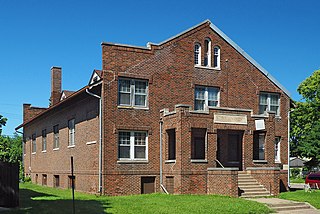
The Serbian Home is a two-story brick building, that was built in 1924 in South Saint Paul in the U.S. state of Minnesota. It was built as a community center for Serbian immigrants who worked in the meatpacking industry. It served as a museum respecting the multitude of ethnic groups who have made the city their home until 2020, when it was purchased and renovated by Serbian immigrant Aleksandar Stojmenovic to serve as an event center.
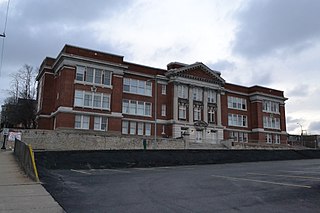
The Robidoux School is a historic school building located at 201 South 10th in St. Joseph, Missouri. It was the first building used by what would become Missouri Western State University. The first high school in St. Joseph was built on the site in 1866. In 1895 the high school moved to 13th and Patee and the building was remodeled to be a grammar school named after St. Joseph founder Joseph Robidoux. In 1907 the building was razed and architect Edmond Jacques Eckel and Walter Boschen was commissioned to design the new Classical Revival style building which opened in 1909 at a cost of $130,000 including contents. It included 12 classrooms and an auditorium seating 1,100. In 1914, the building was used as a freshman annex for Central High School. In 1919 it became the Robidoux Polytechnic High School, a vocational trade school. In 1933 it became home for the St. Joseph Junior College which had been founded in 1915 and was earlier operating out of Central High School. The move occurred at the same time as the Central High School moved to its current location. In 1965 the Junior College became a four-year Missouri Western State College. In 1969 the college moved to its current location on the east side of St. Joseph.

St. Stanislaus Seminary is a former Society of Jesus (Jesuits) seminary that was founded in 1823 on the outskirts of Florissant, Missouri within the current municipal limits of Hazelwood, Missouri. It was the longest continuously operated Jesuit novitiate in the United States.
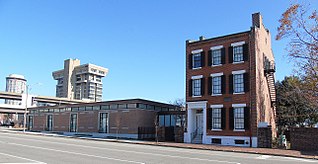
The Eugene Field House is a historic house museum in St. Louis, Missouri. Built in 1845, it was the home of Roswell Field, an attorney for Dred Scott in the landmark Dred Scott v. Sandford court case. Field's son, Eugene Field, was raised there and became a noted writer of children's stories. A National Historic Landmark, it is now a museum known as the Field House Museum.

St. Francis Xavier Church, or Old Bohemia, is a historic Roman Catholic church located at Warwick, Cecil County, Maryland, United States.

The Cathedral of St. Joseph is a Catholic cathedral in St. Joseph, Missouri, United States. Along with the Cathedral of the Immaculate Conception in Kansas City, Missouri it is the seat of the Diocese of Kansas City-St. Joseph. The Cathedral Church, rectory and convent are all contributing properties to the Cathedral Hill Historic District on the National Register of Historic Places. The school building and the auditorium do not contribute to the historical nature of the district.
Edmond Jacques Eckel (1845–1934) was an architect in Missouri. One of his firms was Eckel & Mann. Eckel's name has been spelled with variations including Edmund rather than Edmond and with Jacques spelled as Jaques.
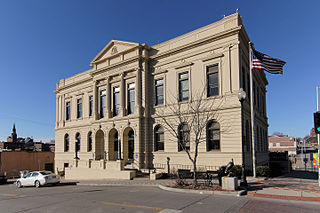
St. Joseph Public Library, also known as Free Public Library, Public Museum, Public Library, and Board of Education Building, is a historic library building located at St. Joseph, Missouri. This library has over 9,000 books. It was designed by the architect Edmond Jacques Eckel (1845–1934) and built in 1901–1902 in the French Baroque style. It is a two-story, brick and reinforced concrete building sheathed in beige marble and limestone. It has a red hipped roof topped by a skeletal glazed dome. It features a pedimented projecting central bay and entrance loggia.

Edmond Jacques Eckel House is a historic home located at St. Joseph, Missouri. It was designed by the architect Edmond Jacques Eckel (1845–1934) and built in 1885. It is a 2 1/2-story, brick dwelling with a truncated hipped roof. It measures 25 feet wide and 36 feet deep. It features a small, flat roofed, wood entrance portico with Tuscan order columns.
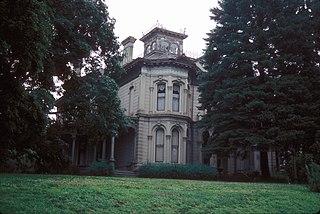
Robidoux Hill Historic District is a national historic district located at St. Joseph, Missouri. The district encompasses 61 contributing buildings in a predominantly residential section of St. Joseph. It developed between about 1865 and 1909, and includes representative examples of Italianate, Second Empire, and Queen Anne style architecture. Located in the district is the separately listed Edmond Jacques Eckel House designed by architect Edmond Jacques Eckel (1845–1934). Other notable buildings include the Lemon House (1871), Donovan House, McKinney House (1887), Inslee House, Jonathan M. Bassett, and U.S. Weather Bureau Building (1909).
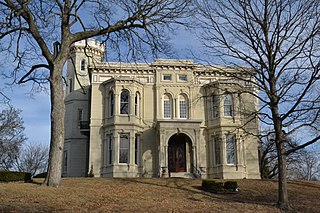
Museum Hill Historic District is a national historic district located at St. Joseph, Missouri. The district encompasses 248 contributing buildings in a predominantly residential section of St. Joseph. It developed between about 1860 and 1942, and includes representative examples of Italianate, Second Empire, Queen Anne, Tudor Revival, American Foursquare, and Bungalow / American Craftsman style architecture. Located in the district is the separately listed Robidoux School. Other notable buildings include the First Congregational Church (1890), Francis Street Methodist Church (1905), First Baptist Church (1896) designed by architect Edmond Jacques Eckel (1845–1934), United Presbyterian Church (1901), First Church of Christ Scientist (1905), First English Evangelical Lutheran Church (1913), and Queen of the Apostles Roman Catholic Church (1908) designed by Eckel.
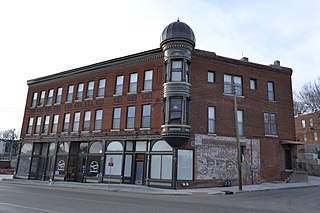
Ryan Block is a historic commercial building located at St. Joseph, Missouri. It was built in 1889, and is a three-story, trapezoidal shaped, Italianate style brick building. It consists of three units in a row with common walls and cast iron storefronts. It features a dentillated metal cornice and a two-story oriel window sheathed in decorative metal.

Pleasant Hill Downtown Historic District is a national historic district in Pleasant Hill, Cass County, Missouri. The district includes 53 contributing buildings, a contributing site, and a contributing structure in the central business district of Pleasant Hill. It developed between about 1865 and 1959, and includes representative examples of Italianate, Jacobethan Revival, Colonial Revival, Classical Revival, and Modern Movement style architecture. Notable buildings include:

Frederick Krause Mini Mansion, also known as the Ben Ferrel Platte County Museum, is a historic mansion located at Platte City, Platte County, Missouri. It was built in 1882-1883 by Frederic Krause, an immigrant from Prussia. The mini mansion is a two-story, modified "T"-plan, Second Empire style red brick building with limestone corner quoins and foundation. It is topped by a mansard roof with gray-blue and rose hexagonal slate. The roof and porches are crested with ornamental cast iron work. The home is referred to as a 'mini' mansion because it shares several architectural features with the Missouri Governor's Mansion built in 1871. An interior, bronze fireplace surround also represents similar design to the white marble one found in the Governor's Mansion in Jefferson City. The Krause mini mansion houses the Ben Ferrel Museum and genealogical and historical research room for the Platte County Historical Society known by the acronym PCHS. The Platte County Historical Society owns and operates the building which opened to the public in 1985. The museum's collection presents regional history with furnishings and items donated entirely from local families and dating mainly from the mid 1800s to 1920. The museum features exhibits and other special events related to local history and the mini mansion's history.

Stone Row is a historic building located at St. Charles, St. Charles County, Missouri. It consists of two 2 1/2-story stone buildings built about 1815 that were once separated by a 20-foot space. About 1860, the space was filled by a 2 1/2-story brick structure. Stone Row dates to the earliest settlement of St. Charles. They were built for commercial and residential purposes.




















